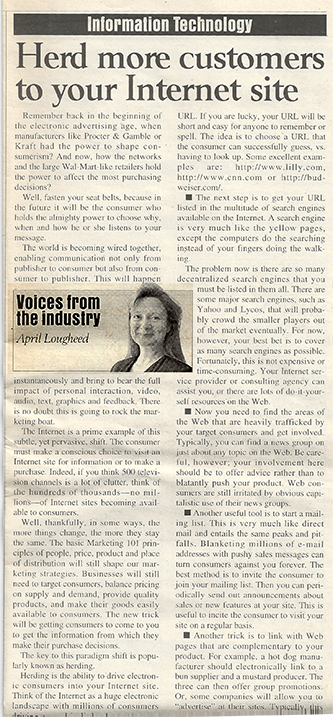Herd more customers to your Internet site.
Indianapolis Business Journal (IBJ)
Information Technology - Voices from the Industry
Week of February 26th to March 3, 1996
by April Lougheed
 Remember back in the beginning of the electronic advertising age, when manufacturers like Proctor & Gamble or Kraft had the power to shape consumerism? And now, how the networks and the large Wal-Mart retailers hold the power to affect the most purchasing decisions?
Remember back in the beginning of the electronic advertising age, when manufacturers like Proctor & Gamble or Kraft had the power to shape consumerism? And now, how the networks and the large Wal-Mart retailers hold the power to affect the most purchasing decisions?
Well, fasten your seat belts, because in the future it will be the consumer who holds the almighty power to choose why, when and how he or she listens to your message.
The world is becoming wired together, enabling communication not only from publisher to consumer but also from consumer to publisher. This will happen instantaneously and bring to bear the full impact of personal interaction, video, audio, text, graphics and feedback.
There is no doubt this is going to rock the marketing boat.
The Internet is a prime example of this subtle, yet pervasive, shift. The consumer must make a conscious choice to visit an Internet site for information or to make a purchase. Indeed, if you think 500 television channels is a lot of clutter, think of the hundreds of thousands - no millions-of Internet sites becoming available to consumers.
Well, thankfully. In some ways, the more things change, the more they stay the same. The basic Marketing 101 principles of people, price, product and place of distribution will still shape our marketing strategies. Businesses will still need to target consumers, balance pricing on supply and demand, provide quality products, and make their goods easily available to consumers. The new trick will be getting consumers to come to you to get the information from which they make their purchase decisions. The key to this paradigm shift is popularly known as herding.
Herding is the ability to drive electronic consumers into your Internet site. Think of the Internet as a huge electronic landscape with millions of consumers driving around in little electronic cars. How are you going to get them to drive into your cyberspace store?
Given the way new technology is changing, new ways to herd will inevitably appear. For now, however, here are the basics:
- First and most obvious is that you need to get your URL (such as http://www.ibm.com) plastered on every single piece of literature, sound bite, package, advertisement, business card and/or public relations tool your company produces. You should print it on everything from your company's motor vehicles to your packing materials.
- You must be careful how you choose the words that make up your URL. If you are lucky, your URL will be short and easy for anyone to remember or spell. The idea is to choose a URL that the consumer can successfully guess, versus having to look up. Some excellent examples are: http://www.lilly.com, http://www.cnn.com, or http://budweiser.com/.
- The next step is to get your URL listed in the multitude of search engines available on the Internet. A search engine is very much like the yellow pages, except the computers do the searching instead of your fingers doing the walking.
The problem now is there are so many decentralized search engines that you must be listed in them all. There are some major search engines, such as Yahoo and Lycos that will probably crowd the smaller players out of the market eventually. For now, however, your best bet is to cover as many search engines as possible. Fortunately, this is not expensive or time-consuming. Your Internet service provider or consulting agency can assist you, or there are lots of do-it-yourself resources on the Web. - Now you need to find the areas of the Web that are heavily trafficked with your target consumers and get involved. Typically, you can find a news group on just about any topic on the Web. Be careful. However; your involvement here should be to offer advice rather than to blatantly push your product. Web consumers are still irritated by obvious capitalistic use of their news groups.
- Another useful tool is to start a mailing list. This is very much like direct mail and entails the same peaks and pitfalls. Blanketing millions of e-mail addresses with pushy sales messages can turn consumers against you forever. The best method is to invite the consumer to join your mailing list. Then you can periodically send out announcements about sales or new features at your site. This is useful to incite the consumer to visit your site on a regular basis.
- Another trick is to link with Web pages that are complementary to your product. For example, a hot dog manufacturer should electronically link to a bun supplier and a mustard producer. The three can then offer group promotions. Or, some companies will allow you to “advertise" at their sites. Typically, this is a brief positioning statement or other offer embedded in a popular site. For example, you may be able to insert an electronic advertising link on a popular news Web site, such as that of USA Today.
These are just basic herding techniques, and new tools are constantly emerging. However, you should start thinking right now about how you are going to adjust your marketing strategies to herd consumers to your electronic store. Remember, even in cyberspace, the early birds will get the worms.
Lougheed is president of Lockheed Guidance, Inc., a consulting firm specializing in the internet. Opinions expressed here are the writer's.